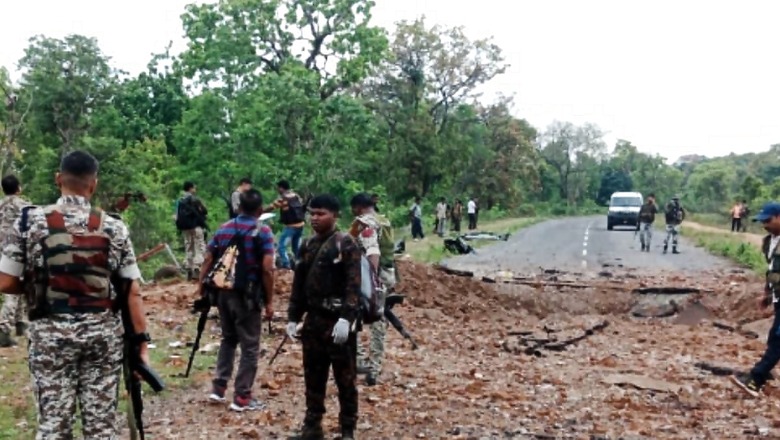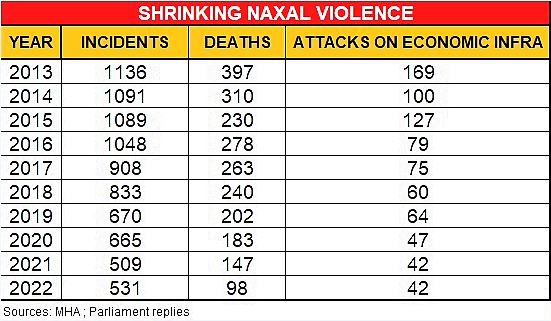
views
As the Narendra Modi-led government approaches the end of its second term, one of its most significant achievements has been its success in controlling the Left-Wing Extremism (LWE) or the Naxalism in the country. Not only has Maoist violence gone down, but the area of influence of Left extremists has also shrunk considerably in over the last nine years.

According to the available data, Naxal-related violence in the country has decreased by over 70% from 1,136 incidents in 2013 to 531 last year. The number of deaths related to these violence has also plummeted by over 75% from 397 deaths in 2014 to 98 last year.
This year, up to July 15, nearly 336 Naxal-related incidents took place in which 79 deaths have been reported.

The geographical spread of LWE violence has also witnessed significant reduction. While in 2013, 330 Police Stations in 76 districts spread over 10 states were impacted by Naxal-related violence, but by 2022, it had contracted by nearly half to 176 police stations in 45 districts spanning eight states, according to the Ministry of Home Affairs (MHA) data.
Furthermore, the extent of violence has significantly reduced, with just 25 districts accounting for 90% of the LWE-related incidents.
Since 2022, the government has maintained separate data for Naxal-perpetrated incidents and those counter offensive moves initiated by the security forces, showcasing its aggressive approach in curbing Naxal-induced violence.
The Maoists aim to isolate the population, particularly the tribal and economically disadvantaged communities, residing in their strongholds from the broader society. They have gained notoriety for sabotaging infrastructure such as roads and communication networks, effectively isolating these populations from mainstream India.
However, despite their best efforts to damage these facilities, security forces have successfully established control in many areas where the Maoists once held sway. Consequently, there has been a significant decline in Maoist attacks on economic infrastructure, with incidents decreasing from 169 in 2013 to just 42 last year, representing a decline of over 75%, according to the government statistics.
Chhattisgarh, Jharkhand, Odisha, Bihar, West Bengal, Andhra Pradesh, Telangana, Maharashtra, Madhya Pradesh, and Kerala are all regarded as being affected by Naxalism, albeit to varying extents.
The CPI (Maoist) remains the most formidable among the various LWE groups in the country, responsible for over 90% of all Naxal-related violent incidents and 95% of associated fatalities.
According to the MHA literature, this deadly organisation is a fusion of numerous splinter groups, resulting from the merger of the two largest Maoist groups in 2004: The Communist Party of India (Marxist-Leninist), People’s War, and the Maoist Communist Centre of India.
The CPI (Maoist) and all its affiliated front organisations have been designated as banned terrorist organisations under the Unlawful Activities (Prevention) Act of 1967.
The successes against these hardcore Naxal organisations have not come easily; they are the result of relentless and comprehensive efforts by the government on multiple fronts, coupled with the sacrifices made by our brave security forces.
On May 25, 2013, just a year before Modi assumed office as Prime Minister for the first time on May 26, 2014, India witnessed one of the deadliest Maoist attacks. In an ambush set in the Darbha Valley of Sukma district, Chhattisgarh, the Naxals killed 25 leaders of the Congress. Among those tragically lost were former state minister Mahendra Karma and then Chhattisgarh Congress chief Nand Kumar Patel.
Karma, a formidable tribal leader of the Congress in southern Chhattisgarh, had founded Salwa Judum to combat the Maoists. His strong opposition to the Naxals made him a prime target. After assassinating him, the Red ultras reportedly danced on his lifeless body. Subsequent reports revealed that a group of determined female Naxal combatants took turns stabbing him a horrifying 78 times, ensuring he endured maximum pain before meeting his demise.
The sheer brutality of these killings sent shockwaves throughout the nation. At the time, Narendra Modi, serving as the Chief Minister of Gujarat, had called for a policy of unwavering zero tolerance towards terrorism and Naxalism.
“Gruesome attack in Chhattisgarh is an attack on democracy. Time has come to adopt policy of zero tolerance towards terrorism and Naxalism,” Modi had tweeted adding that “the need of the hour is to stand together as a nation and vow to fight this menace that threatens our democracy.”
The killing of these leaders once again underscored how left-wing extremism has presented a substantial challenge to democracy. This menace has not only impeded development in various regions but has also, as per a 2022 report by the Ministry of Home Affairs, resulted in the tragic loss of 16,652 lives, including security personnel and civilians.
Though, according to the constitutional arrangement subjects of Police and Public Order are with the state governments (Seventh Schedule of the Constitution of India), the Central government has been aggressively supplementing the efforts of LWE affected states in combating the Maoist threat.
The approval of a National Policy and Action Plan in 2015 marked a significant step in addressing the threat. This comprehensive approach encompasses security-related measures, development interventions, and safeguarding the rights and entitlements of local communities.
In terms of security, the Central government aids LWE-affected states through Central Armed Police Force (CAPF) battalions, training, providing helicopters for combat operations, financial support via special schemes such as Security Related Expenditure (SRE) and Special Infrastructure Scheme (SIS), state police force modernisation, equipment provision, intelligence sharing, and constructing fortified police stations, among other measures.
“The underlying philosophy is to enhance the capacity of the state governments to tackle the Maoist menace in a concerted manner,” according to the MHA note.
During a meeting of the Parliamentary Consultative Committee on Left-Wing Extremism at the home ministry in February this year, Amit Shah revealed that since 2019, security forces have made significant strides by establishing 175 new camps in LWE-affected areas. This effort has helped reduce security vacuums and rendered the top leadership of Left Wing Extremists ineffective.
Further, the BSF air-wing has bolstered its capabilities by welcoming new pilots and engineers. This reinforcement is aimed at supporting operations in LWE-affected regions and safeguarding the lives of our forces.
Shah said as a result of these efforts, success has been achieved against Naxals in difficult areas such as Buddha Pahad (Jharkhand) and Chakarbandha forests (Bihar) claiming Bihar, Jharkhand and Odisha have been almost freed from Left Wing Extremism.
Buddha Pahad stands out as a significant achievement of security forces, given its status as the last stronghold of Maoists on the Bihar-Jharkhand border. This 55-square-kilometer hilly region was successfully cleared of Maoists through a determined and protracted operation conducted last year. The security forces, according to reports, had struggled to penetrate the core area, spanning roughly 10 square kilometres, for the past three decades.
Furthermore, the MHA and various other agencies have been diligently working to dismantle the entire network responsible for financing Naxal activities, including their over-ground sympathisers commonly referred to as “urban naxals” and workers.
In October 2022, while addressing the Chintan Shivir of home ministers of states held in Surajkund, Haryana, PM Modi had said, “We will have to defeat all forms of Naxalism — be it gun-toting or pen-wielding, we will have to find a solution for all of them”.
Furthermore, in order to boost the investigation against the red ultras, a dedicated division has been established within the NIA to expedite investigations related to Left-Wing militants.
On the development front, the Central government implements several initiatives such as road construction for better mobility, mobile tower installation for communication, enhancing the network of banks, post offices, and improving healthcare and educational facilities.
Development Projects in LWE Areas
Replying to a question in Lok Sabha on the development projects in LWE areas, MoS Home Nityanand Rai last month informed that 13,234 km roads have been added, and for better telecom connectivity, 2,343 mobile towers were installed in Phase-I of the Mobile Tower Project.
Nearly 927 bank branches, 944 ATMs, and 27,513 banking correspondents were established in 30 most LWE affected districts since April 2015 to promote financial inclusion.
Additionally, 4,903 new post offices were opened in 90 districts over the past eight years. For skill development, 43 ITIs and 38 Skill Development Centres were established in LWE-affected districts.
To enhance the quality of education in tribal blocks, 125 Eklavya Model Residential Schools were established in 90 LWE-affected districts.
Besides, Shah has held meetings of Chief Ministers of LWE affected states from time to time to review the situation and monitor the progress of the schemes. According to MHA’s Left Wing Extremism Division four meetings have been held so far on February 9, 2015, May 8, 2017, August 26, 2019 and on September 26, 2021.
From time to time, ministers of the MHA and top officials also visit LWE affected states to get first-hand exposure of the prevailing situation.
For the first time, in March this year, the CRPF’s 84th Raising Day event took place in the Naxal-affected Bastar district of Chhattisgarh and was graced by the presence of Shah.
The developmental outreaches of the government and relentless crackdown by the security forces have led to a growing number of LWE cadres renouncing violence and reintegrating into mainstream society. According to an MHA report, the number of LWE militants who surrendered has increased from 2,428 between 2006 and 2014 to 5,816 between 2014 and 2022.
The achievements against LWE have given the government much to cheer about. “Our efforts are on to ensure that the entire country is free from the Naxal problem by 2024,” Shah had said in a public meeting in Chhattisgarh in January.
Nonetheless, it is essential to refrain from premature celebration until the issue is unequivocally resolved. This April, 10 DRG jawans and one driver lost their lives in an explosion orchestrated by Naxals in Chhattisgarh’s Dantewada.
The current imperative is to maintain pressure on LWEs to abandon violence, integrate them into mainstream society, and acknowledge that the socio-economic and political dynamics and aspirations of the new India are fundamentally different from the Maoist outlook.
Furthermore, an ideology rooted in violence and destruction has severe limitations and is bound to fall terribly short in a democratic setup where numerous legitimate channels are available for addressing concerns.


















Comments
0 comment